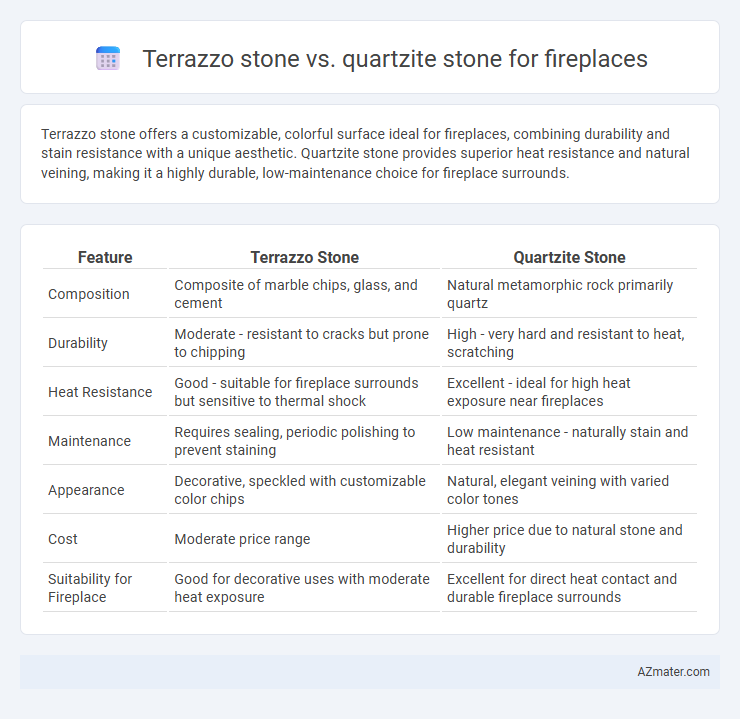Terrazzo stone offers a customizable, colorful surface ideal for fireplaces, combining durability and stain resistance with a unique aesthetic. Quartzite stone provides superior heat resistance and natural veining, making it a highly durable, low-maintenance choice for fireplace surrounds.
Table of Comparison
| Feature | Terrazzo Stone | Quartzite Stone |
|---|---|---|
| Composition | Composite of marble chips, glass, and cement | Natural metamorphic rock primarily quartz |
| Durability | Moderate - resistant to cracks but prone to chipping | High - very hard and resistant to heat, scratching |
| Heat Resistance | Good - suitable for fireplace surrounds but sensitive to thermal shock | Excellent - ideal for high heat exposure near fireplaces |
| Maintenance | Requires sealing, periodic polishing to prevent staining | Low maintenance - naturally stain and heat resistant |
| Appearance | Decorative, speckled with customizable color chips | Natural, elegant veining with varied color tones |
| Cost | Moderate price range | Higher price due to natural stone and durability |
| Suitability for Fireplace | Good for decorative uses with moderate heat exposure | Excellent for direct heat contact and durable fireplace surrounds |
Overview: Terrazzo Stone vs Quartzite Stone
Terrazzo stone is a composite material made from marble, quartz, granite, or glass chips embedded in cement or resin, offering high durability and customizable patterns ideal for fireplace surrounds. Quartzite stone, a natural metamorphic rock formed from sandstone, provides exceptional hardness and heat resistance with a unique, natural veining that enhances fireplace aesthetics. Both materials deliver strong thermal properties, but terrazzo allows more design flexibility while quartzite offers superior natural stone authenticity.
Aesthetic Differences Between Terrazzo and Quartzite
Terrazzo stone showcases a vibrant, speckled aesthetic created by embedded chips of marble, glass, or quartz, offering a customizable and artistic look for fireplace surrounds. Quartzite stone features a natural, earthy appearance with flowing veining and subtle color variations that provide a timeless, organic elegance. The polished finish of quartzite highlights its depth and texture, while terrazzo's unique composite design adds a modern, playful contrast to fireplace designs.
Durability: Terrazzo vs Quartzite for Fireplaces
Terrazzo stone offers excellent durability for fireplaces due to its composite nature, combining marble, quartz, and glass chips bound with cement or epoxy, making it highly resistant to heat and wear. Quartzite stone rivals Terrazzo in durability with its natural formation from quartz sandstone, boasting superior hardness and resistance to heat, scratches, and stains, ensuring long-lasting performance. Both materials provide strong thermal resistance, but quartzite's natural strength often results in greater longevity under intense fireplace conditions.
Heat Resistance: Which Stone Performs Better?
Terrazzo stone, composed of marble, quartz, granite, and glass chips embedded in cement or resin, offers moderate heat resistance but can be susceptible to thermal shock and discoloration under direct intense heat. Quartzite stone, a natural metamorphic rock primarily of quartz, exhibits superior heat resistance and durability, making it more suitable for fireplaces exposed to high temperatures. For optimal fireplace performance, quartzite's ability to withstand rapid temperature changes and maintain structural integrity outperforms terrazzo.
Maintenance Requirements for Fireplace Use
Terrazzo stone requires regular sealing to protect against stains and maintain its polished surface, making maintenance moderately demanding for fireplace applications. Quartzite stone offers superior durability and heat resistance with minimal sealing needed, resulting in lower maintenance and enhanced longevity for fireplace surroundings. Both materials benefit from routine cleaning, but quartzite's natural hardness makes it more resistant to scratches and discoloration over time.
Cost Comparison: Terrazzo vs Quartzite
Terrazzo stone typically costs between $50 to $100 per square foot, making it a more budget-friendly option compared to quartzite, which ranges from $70 to $150 per square foot. The pricing difference is influenced by factors such as fabrication complexity, material durability, and design customization. Homeowners seeking a cost-effective yet stylish fireplace surface often prefer terrazzo for its affordability and versatility.
Installation Process and Considerations
Terrazzo stone installation for fireplaces involves pouring a mixture of marble, quartz, granite chips, and cement-based binder, requiring skilled labor and proper curing time to avoid cracks and ensure durability. Quartzite stone installation demands precise cutting and anchoring due to its natural hardness and brittleness, typically using mechanical fasteners or mortar for stability. Considerations include Terrazzo's customizability and maintenance of grout lines versus Quartzite's high heat resistance and minimal maintenance, influencing long-term performance and aesthetic appeal in fireplaces.
Customization and Design Flexibility
Terrazzo stone offers exceptional customization and design flexibility for fireplaces due to its composite nature, allowing for a wide range of colors, patterns, and aggregate sizes tailored to specific aesthetic preferences. Quartzite stone provides a natural, elegant appearance with limited customization options, as its design is primarily dictated by natural veining and color variations. The versatility of terrazzo makes it ideal for unique, modern fireplace designs, whereas quartzite suits more traditional, timeless styles.
Environmental Impact and Sustainability
Terrazzo stone offers high sustainability due to its incorporation of recycled materials like glass and marble chips, reducing waste and reliance on virgin resources. Quartzite stone, while natural and durable, requires extensive quarrying that can lead to significant environmental disturbance and higher carbon emissions. Choosing terrazzo for fireplaces supports eco-friendly building practices by promoting recycled content and reducing the ecological footprint associated with stone extraction.
Choosing the Right Stone for Your Fireplace
Terrazzo stone offers a customizable, polished surface combining marble, quartz, granite, and glass chips, providing a unique aesthetic with high durability and resistance to heat, making it suitable for fireplace surrounds. Quartzite stone, a natural metamorphic rock, boasts exceptional hardness and heat resistance, with a more subtle, natural texture ideal for rustic or classic fireplace designs. When choosing the right stone for your fireplace, consider factors like maintenance requirements, heat tolerance, visual appeal, and budget, as terrazzo requires sealing to prevent stains, while quartzite demands less upkeep and withstands high temperatures effectively.

Infographic: Terrazzo stone vs Quartzite stone for Fireplace
 azmater.com
azmater.com